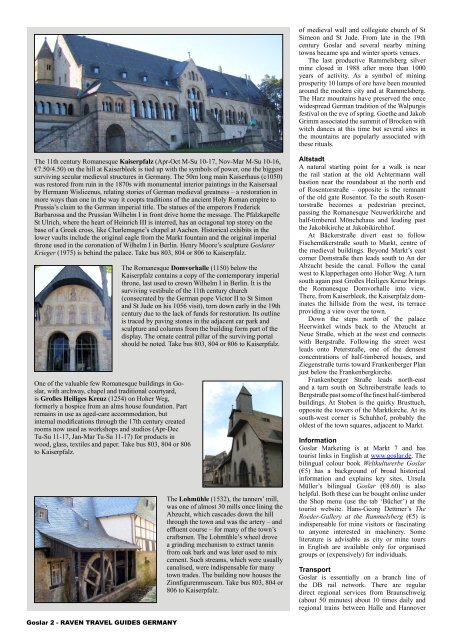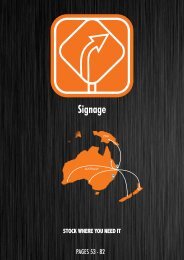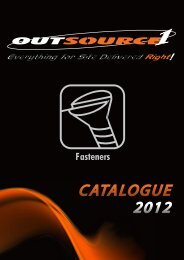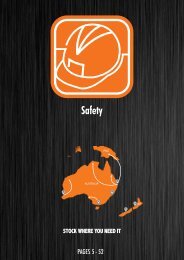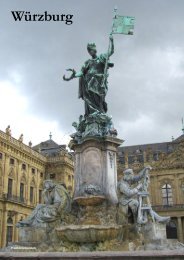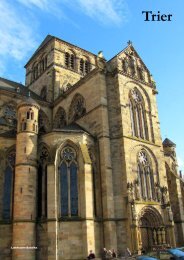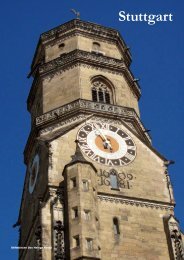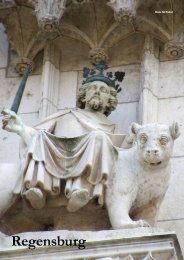Raven Guides: Germany - Goslar
You also want an ePaper? Increase the reach of your titles
YUMPU automatically turns print PDFs into web optimized ePapers that Google loves.
of medieval wall and collegiate church of St<br />
Simeon and St Jude. From late in the 19th<br />
century <strong>Goslar</strong> and several nearby mining<br />
towns became spa and winter sports venues.<br />
The last productive Rammelsberg silver<br />
mine closed in 1988 after more than 1000<br />
years of activity. As a symbol of mining<br />
prosperity 10 lumps of ore have been mounted<br />
around the modern city and at Rammelsberg.<br />
The Harz mountains have preserved the once<br />
widespread German tradition of the Walpurgis<br />
festival on the eve of spring. Goethe and Jakob<br />
Grimm associated the summit of Brocken with<br />
witch dances at this time but several sites in<br />
the mountains are popularly associated with<br />
these rituals.<br />
The 11th century Romanesque Kaiserpfalz (Apr-Oct M-Su 10-17, Nov-Mar M-Su 10-16,<br />
€7.50/4.50) on the hill at Kaiserbleek is tied up with the symbols of power, one the biggest<br />
surviving secular medieval structures in <strong>Germany</strong>. The 50m long main Kaiserhaus (c1050)<br />
was restored from ruin in the 1870s with monumental interior paintings in the Kaisersaal<br />
by Hermann Wislicenus, relating stories of German medieval greatness – a restoration in<br />
more ways than one in the way it coopts traditions of the ancient Holy Roman empire to<br />
Prussia’s claim to the German imperial title. The statues of the emperors Frederick<br />
Barbarossa and the Prussian Wilhelm I in front drive home the message. The Pfalzkapelle<br />
St Ulrich, where the heart of Heinrich III is interred, has an octagonal top storey on the<br />
base of a Greek cross, like Charlemagne’s chapel at Aachen. Historical exhibits in the<br />
lower vaults include the original eagle from the Markt fountain and the original imperial<br />
throne used in the coronation of Wilhelm I in Berlin. Henry Moore’s sculpture <strong>Goslar</strong>er<br />
Krieger (1975) is behind the palace. Take bus 803, 804 or 806 to Kaiserpfalz.<br />
One of the valuable few Romanesque buildings in <strong>Goslar</strong>,<br />
with archway, chapel and traditional courtyard,<br />
is Großes Heiliges Kreuz (1254) on Hoher Weg,<br />
formerly a hospice from an alms house foundation. Part<br />
remains in use as aged-care accommodation, but<br />
internal modifications through the 17th century created<br />
rooms now used as workshops and studios (Apr-Dec<br />
Tu-Su 11-17, Jan-Mar Tu-Sa 11-17) for products in<br />
wood, glass, textiles and paper. Take bus 803, 804 or 806<br />
to Kaiserpfalz.<br />
The Romanesque Domvorhalle (1150) below the<br />
Kaiserpfalz contains a copy of the contemporary imperial<br />
throne, last used to crown Wilhelm I in Berlin. It is the<br />
surviving vestibule of the 11th century church<br />
(consecrated by the German pope Victor II to St Simon<br />
and St Jude on his 1056 visit), torn down early in the 19th<br />
century due to the lack of funds for restoration. Its outline<br />
is traced by paving stones in the adjacent car park and<br />
sculpture and columns from the building form part of the<br />
display. The ornate central pillar of the surviving portal<br />
should be noted. Take bus 803, 804 or 806 to Kaiserpfalz.<br />
The Lohmühle (1532), the tanners’ mill,<br />
was one of almost 30 mills once lining the<br />
Abzucht, which cascades down the hill<br />
through the town and was the artery – and<br />
effluent course – for many of the town’s<br />
craftsmen. The Lohmühle’s wheel drove<br />
a grinding mechanism to extract tannin<br />
from oak bark and was later used to mix<br />
cement. Such streams, which were usually<br />
canalised, were indispensable for many<br />
town trades. The building now houses the<br />
Zinnfigurenmuseum. Take bus 803, 804 or<br />
806 to Kaiserpfalz.<br />
Altstadt<br />
A natural starting point for a walk is near<br />
the rail station at the old Achtermann wall<br />
bastion near the roundabout at the north end<br />
of Rosentorstraße – opposite is the remnant<br />
of the old gate Rosentor. To the south Rosentorstraße<br />
becomes a pedestrian precinct,<br />
passing the Romanesque Neuwerkkirche and<br />
half-timbered Mönchehaus and leading past<br />
the Jakobikirche at Jakobikirchhof.<br />
At Bäckerstraße divert east to follow<br />
Fischemäkerstraße south to Markt, centre of<br />
the medieval buildings. Beyond Markt’s east<br />
corner Domstraße then leads south to An der<br />
Abzucht beside the canal. Follow the canal<br />
west to Klapperhagen onto Hoher Weg. A turn<br />
south again past Großes Heiliges Kreuz brings<br />
the Romanesque Domvorhalle into view.<br />
There, from Kaiserbleek, the Kaiserpfalz dominates<br />
the hillside from the west, its terrace<br />
providing a view over the town.<br />
Down the steps north of the palace<br />
Heerwinkel winds back to the Abzucht at<br />
Neue Straße, which at the west end connects<br />
with Bergstraße. Following the street west<br />
leads onto Peterstraße, one of the densest<br />
concentrations of half-timbered houses, and<br />
Ziegenstraße turns toward Frankenberger Plan<br />
just below the Frankenbergkirche.<br />
Frankenberger Straße leads north-east<br />
and a turn south on Schreiberstraße leads to<br />
Bergstraße past some of the finest half-timbered<br />
buildings. At Stoben is the quirky Brusttuch,<br />
opposite the towers of the Marktkirche. At its<br />
south-west corner is Schuhhof, probably the<br />
oldest of the town squares, adjacent to Markt.<br />
Information<br />
<strong>Goslar</strong> Marketing is at Markt 7 and has<br />
tourist links in English at www.goslar.de. The<br />
bilingual colour book Weltkulturerbe <strong>Goslar</strong><br />
(€5) has a background of broad historical<br />
information and explains key sites. Ursula<br />
Müller’s bilingual <strong>Goslar</strong> (€8.60) is also<br />
helpful. Both these can be bought online under<br />
the Shop menu (use the tab ‘Bücher’) at the<br />
tourist website. Hans-Georg Dettmer’s The<br />
Roeder-Gallery at the Rammelsberg (€5) is<br />
indispensable for mine visitors or fascinating<br />
to anyone interested in machinery. Some<br />
literature is advisable as city or mine tours<br />
in English are available only for organised<br />
groups or (expensively) for individuals.<br />
Transport<br />
<strong>Goslar</strong> is essentially on a branch line of<br />
the DB rail network. There are regular<br />
direct regional services from Braunschweig<br />
(about 50 minutes) about 10 times daily and<br />
regional trains between Halle and Hannover<br />
<strong>Goslar</strong> 2 - RAVEN TRAVEL GUIDES GERMANY


